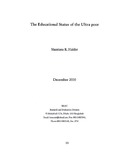The educational status of the ultra poor
Date
2000-12Publisher
Research and Evaluation Division, BracAuthor
Halder, Shantana R.Metadata
Show full item recordCitation
Halder, S. R. (2000). The educational status of the ultra poor. Research Reports (2000), Economic Studies, (XVI), 23–42.Abstract
This report describes the state of education of the ultra poor by considering four
indicators namely: net enrollment rate of children between 6-10 years of age, adult and
household literacy rates, educational status of the household heads and the rate of
"educationally dark" or "enlightened" households. Net enrollment rate was 55%, while
the rural national average was 77%. The rate was highly correlated with amount of
land, quality of housing, sex, occupation and literacy status of the household heads,
household asset base and saving. Increase in income enhances girls' enrollment more
positively. About 51% of the households were educationally dark, where none of the
family members had completed at least one year of education. The number of
educationally dark households was proportionately higher among the landless, femaleheaded
households and also among the destitutes. No direct relationship between this
variable with household income was observed. Household literacy rate was 28%. It was
about twice higher for male than female. Among the female-headed households, male
literacy rate was more than four times higher compared to the female literacy rate.
Similar trend was also observed for the destitutes and the most well-off. Land was
found to be positively correlated with household literacy.

